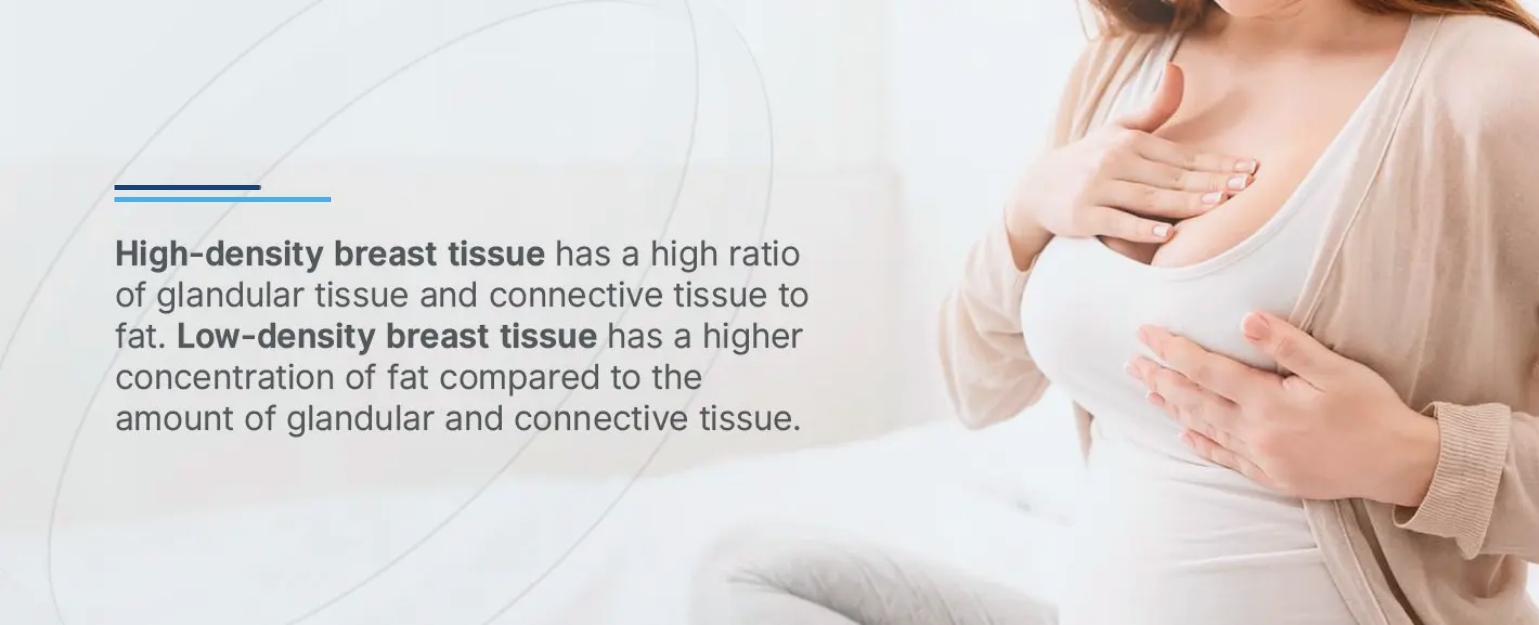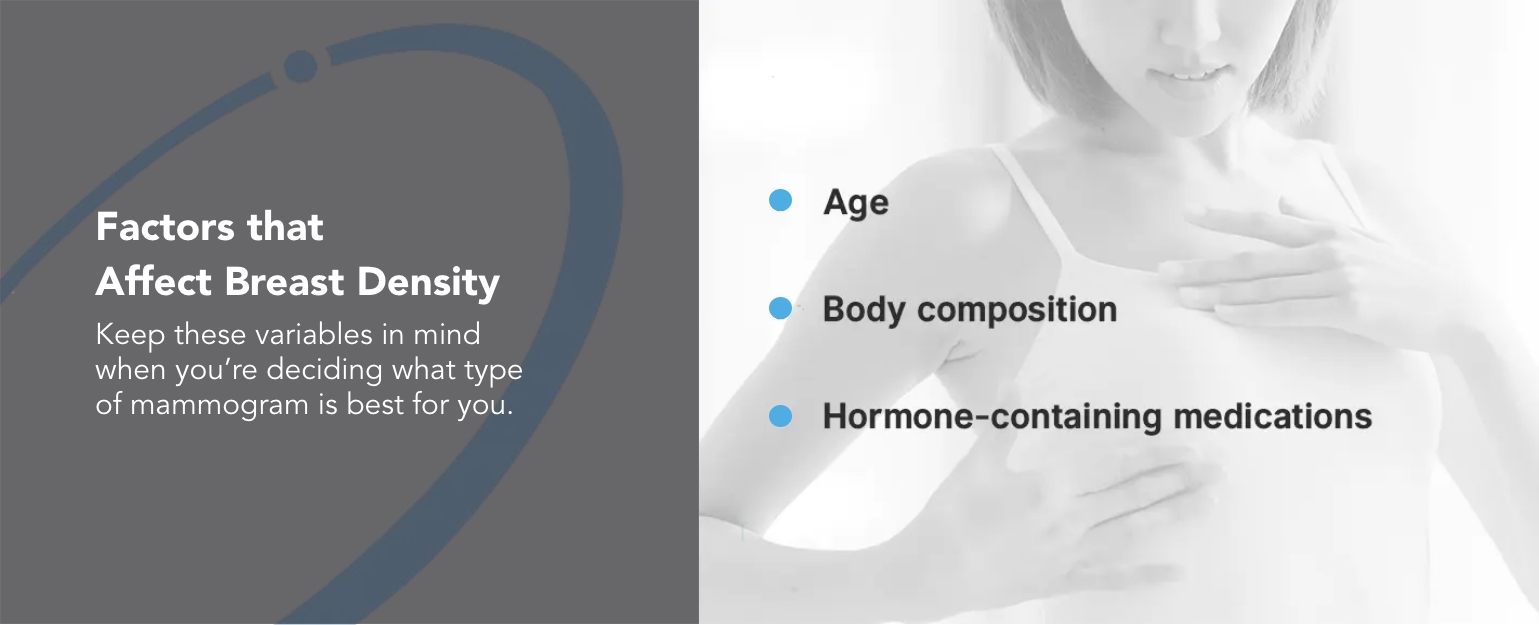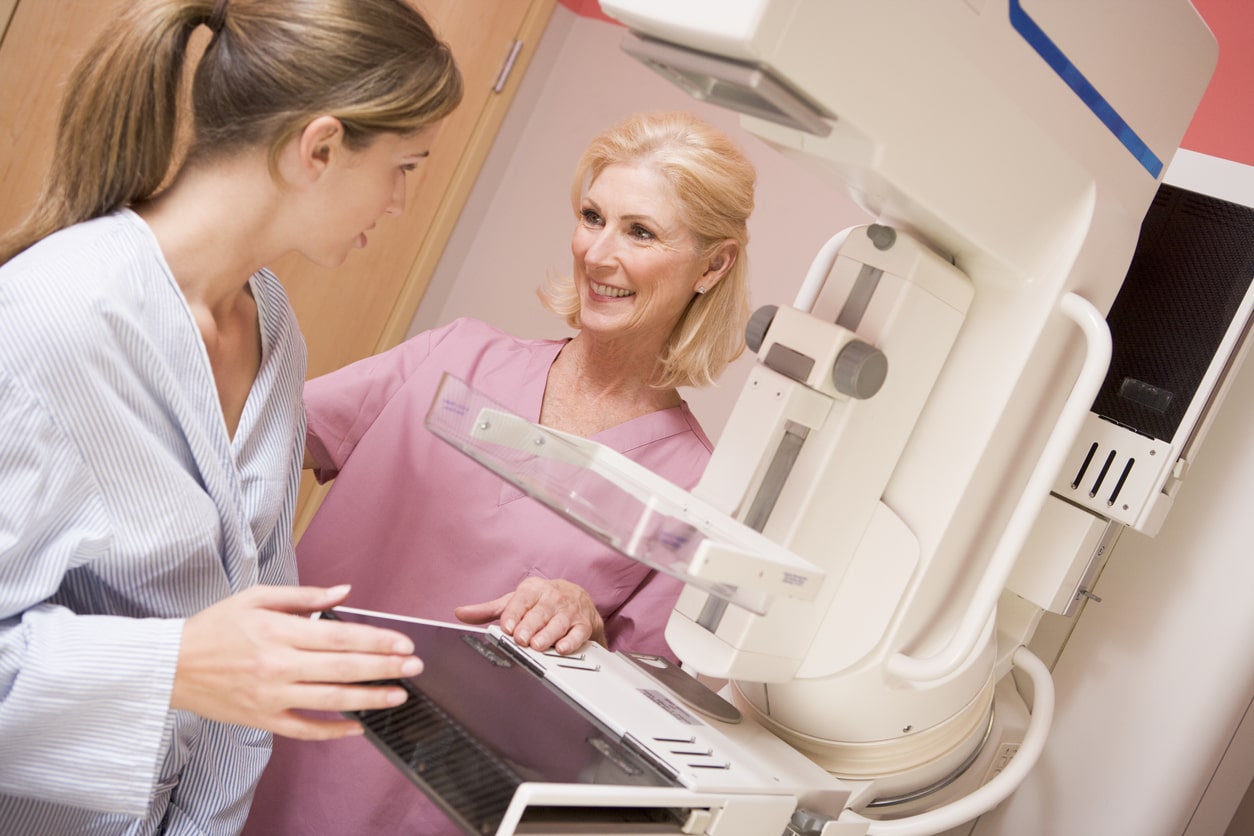Breast Density on Mammograms

Mammograms are part of our first line of defense in fighting breast cancer. They save thousands of lives every year. A recent Swedish study demonstrated that breast cancer patients who took part in a mammography screening program had a 60% lower risk of dying from breast cancer 10 years after diagnosis and a 47% lower risk of dying from breast cancer 20 years after diagnosis.
Every mammogram is unique because no two women have the same breast tissue. One of the most significant variables in mammography involves breast tissue density. The makeup of a woman’s breast tissue can alter her risk for breast cancer and impact the clarity and effectiveness of traditional mammograms.
What Is Breast Density?
To discuss breast density, we first need to examine the composition of breast tissue. Breast tissue consists of milk ducts, lobules — the glands that produce milk — and fat. It also contains connective tissue that binds all these components in place.
The phrase “glandular tissue” refers to the milk ducts and lobules. This tightly packed tissue, along with the breast’s connective tissue, is much denser than the breast’s puffier fat.
So high-density breast tissue has a high ratio of glandular tissue and connective tissue to fat. Low-density breast tissue has a higher concentration of fat compared to the amount of glandular and connective tissue. Some breasts — fatty breasts — are mostly fat, whereas dense breasts are predominantly glandular and connective tissue.
High breast density is relatively prevalent. In the United States, among women aged 40 to 74, approximately 40 to 50% have dense breasts.

How Breast Density Will Appear on Mammograms
On mammogram images, fatty tissue appears gray and transparent, while glandular tissue looks opaque and white. Glandular tissue is, therefore, much harder to see through and may cloud crucial features of the breast composition. Another challenge arises because cancerous areas typically also show up as white on mammogram images. A mammogram of dense tissue may obscure critical details and make it challenging for a radiologist to detect abnormalities.
A woman’s first mammogram may also double as a breast density screening. If you go for a mammogram, the radiologist may tell you that you have either high-density or low-density breasts. The radiologist makes this characterization by looking at the images and evaluating their composition.
Radiologists have developed a system of categories to represent breast type densities as seen on mammogram images. That system is the Breast Imaging Reporting and Data System, and its categories break down like this.
- A: Almost entirely fatty. About one of every 10 women falls into this category. The breast tissue in these women is nearly all fat.
- B: Scattered areas of fibroglandular density. About four of every 10 women fall into this category. Most breast tissue in these women is non-dense, but it does contain a few high-density areas.
- C: Heterogeneously dense. About four of every 10 women fall into this category. The majority of the breast tissue in these women is dense, but the tissue does contain a few lower-density areas.
- D: Extremely dense. About one of every 10 women falls into this category. The breast tissue in these women is almost entirely dense.
In general, health care providers consider women to have dense breasts if they fall into categories C or D.
It’s often helpful to know whether you have high-density or low-density breast tissue — having this information allows you to make the best decisions about your mammograms in the future. The composition of your breasts is likely to alter over time, though, so you’ll want to factor the potential changes into your decision-making.
Schedule a Mammogram at Clear Connect Medical Imaging
Factors that Affect Breast Density

A few different factors can affect breast density. Keep these variables in mind when you’re deciding what type of mammogram is best for you.
- Age: Younger women tend to have denser breasts than older women. Over the years, breast composition changes — causing breast shape to alter over time. Among women aged 40 to 44, between 50 and 50% have dense breasts. Among women aged 70 to 74, only 20 to 30% have dense breasts.
- Body composition: There’s a link between a higher percentage of body fat and fattier, lower-density breasts. Among women considered to have a medically healthy weight, about 50 to 60% have dense breast tissue. Among women who are obese, only 20 to 30% do.
- Hormone-containing medications: The hormones in some medicines can affect breast density. For instance, the drug tamoxifen, designed to help prevent and treat breast cancer, can make breast tissue composition fattier and less dense. Women who take hormone-replacement drugs as part of a treatment plan for menopause may also see their breast tissue lose density.
Getting Mammograms With Dense Breasts
Studies have found women with high-density breast tissue are more likely to develop breast cancer than women with low-density breast tissue. This risk is separate from the fact that high-density breasts are more challenging to image with traditional mammography.
Because of their heightened risk of cancer, as well as the risk that a traditional two-dimensional high-density mammogram will not image their breast tissue thoroughly, some women with dense breasts choose a three-dimensional mammogram instead.
A 3D mammogram is very similar to a traditional mammogram — the process is almost entirely the same. The advantage of a 3D mammogram is that it takes multiple x-ray photos from numerous angles to form a computer-generated composite image of the breasts. Radiologists can then examine the breast tissue level by level, a luxury 2D mammograms do not afford.
Because this level-by-level examination gives a much clearer view of the breast composition and its tiny details, radiologists are more likely to catch abnormalities if they exist. A 3D mammogram is also less likely to generate a false positive, so women don’t need to worry that a mammogram of dense breasts will lead to unnecessary follow-up imaging and worry.
Schedule a Mammogram Appointment at a Location Near You
For the best in early detection and clarity, schedule your next mammogram with Clear Connect Medical Imaging. Our world-class imaging techniques and supportive, experienced technologists mean you’ll gain the peace of mind of knowing your mammogram was clear, thorough and accurate. And the special touches in our imaging setting — we’ll give you relaxing music and a cozy robe if you like — mean you’ll have a comfortable mammogram experience you don’t mind repeating every year.
Book an appointment with Clear Connect Medical Imaging. Find a location near you, and contact us today to learn more.
Call To Schedule Your Appointment
Sources:
- https://www.webmd.com/breast-cancer/news/20181109/mammograms-do-save-lives-study-shows
- https://ww5.komen.org/Breastcancer/Highbreastdensityonmammogram.html
- https://www.mayoclinic.org/tests-procedures/mammogram/in-depth/dense-breast-tissue/art-20123968
- https://www.mayoclinic.org/tests-procedures/mammogram/in-depth/dense-breast-tissue/art-20123968
- https://ww5.komen.org/Breastcancer/Highbreastdensityonmammogram.html
- https://www.cancer.gov/types/breast/breast-changes/dense-breasts



